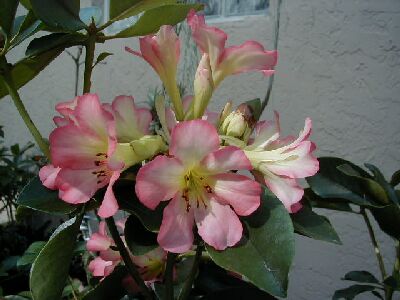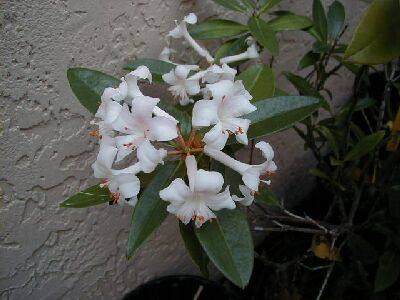R.A. `Mitch' Mitchell, Hawaii, Hawaii
Rhododendrons in Hawaii....ridiculous. Well, yes and no. In our garden in the village of Volcano at 4000 feet on the island of Hawaii (sometimes called 'The Big Island') you may see a few trusses on 'Vulcan', 'Scintillation', 'Gomer Waterer' and R. ponticum. These, however, are a few of what remain from those I bought in the early 1980's after spending several summers in the United Kingdom. It was then that my wife and I fell in love with the genus in places like Harlow Carr, Wisley, Kew, and along the canals we were exploring.

In conversations with British friends we told them about our hydrangeas, azaleas and camellias, our acid, humusy soil ,and cool temperatures in the winter. Their encouragement to try rhododendrons resulted in nursery purchases when we returned home. However, in all our contacts, both in the United Kingdom and the United States, no one told us that it wasn't enough for temperatures to drop to the mid-thirties and low forties at night. They must stay there in the day time as well! Furthermore, they must stay there for three to four weeks to expect to see flowers.
While in the UK in 1984, we heard of plans being made to attend the International Rhododendron Symposium in Federal Way, Washington the next year. A stopover there seemed to coincide with our annual return to England from Volcano. It was a fortuitous decision, because it was there we met E. White Smith and Bob Badger who had only recently begun to edit a newsletter, The Vireya Vine. They encouraged us to forget the hardies and try vireyas.
The Vireya section of the rhododendron genus was not familiar then to many United States nurseries, but we did learn about one with vireyas for sale, Bill and Bettye Moynier's Vireya Specialty Nursery in Los Angeles (no longer in existence). From them we ordered a good selection of plants, both species and hybrids. As you might imagine, they are quite large now, and some are in bloom every month of the year, which is a real plus when compared with others in the genus.
About that time I also learned that Lyon Arboretum on the Island of Oahu sometimes had vireyas available at its annual plant sale. They had been propagated from cuttings provided by Peter Schick and/or the Strybing Arboretum, San Francisco. After bringing in plants from Lyon and VSN we thought we were the only ones with vireyas on this island. Soon we learned that Dr. Clif Druecker was growing plants sent to him by his cousin, John Druecker of Ft. Bragg, CA. Then we read in the newsletter, The Vireya Vine, that they were also being grown by Charles Trommer, a recent transplant from Massachusetts, and Glen Sahara who had moved here from Berkeley, CA. Cuttings from our gardens were shared with friends, and now there are vireyas in gardens on this island from sea level to 4000 ft. Also they have found homes in several gardens on Oahu and at least one on Kauai, Naoaina Kai.
With this amount of interest , it was not surprising that the ARS director of District 5, Barbara Campbell, began to generate interest in the formation of what became the Hawaii Chapter in 1997. The chapter now has 37 members including those from New Zealand, Thailand, England, Denmark and Belgium.

In the year 2000, on March 17-18, the Hawaii Chapter will host a "Vireya Seminar" in Hilo at the Naniloa Hotel. Experts from the University of Hawaii, Hilo, and local nurseries will lead discussions in the mornings, and in the afternoons there will be garden tours. Reservations are anticipated from the mainland United States. as well as the Pacific Ocean area. Reservations may be made with the chapter treasurer:
Sherla Bertelmann, P.O. Box 508, Mountain View, HI 96771. email: tropical@ interpac.net.
Why do vireyas do so well in Hawaii? There will be better answers to this question when our chapter publishes the result of a research study that is recording the progress of five varieties in gardens located from sea level to 4000 feet. We generally agree that soil and climate have characteristics that make for healthy vireya propagation in the ground. Our volcanic origin provides outstanding drainage which vireyas demand. Also in many locations the rain forest environment provides the acid and humusy conditions they like.
As for climate, Atlas of Hawaii, published by the University of Hawaii Press, says: "The character of Hawaii's climate can be explained largely by its geographic location. Ranging from approximately 19 to 22 degrees north latitude, the inhabited islands lie at the margin of the tropics and inside a belt of persistent trade winds and accompanying down-welling of upper-level air". The same source says that if it weren't for the steep sloped high mountains, rainfall would range between 22 and 28 inches per year. This explains why our average annual rainfall ranges from ten inches to 445 inches for the state as a whole.
Usually there is more than enough rain on our islands to keep the vireyas happy. However, El Nino did make an exception and some of our members had to buy water because their water system went dry. In our garden at 4000 feet rainfall can vary between 170 inches to over 200 inches. My observations tell me that vireyas seem to thrive on lots of rain as long as the rain continues on down through the lava base and isn't allowed to sit in a pool around the roots. Of course, the fertilizer goes on down with it which means that more frequent fertilizing is required. So much for growth, but for flowering different varieties have their own sun requirements which must be reckoned with. I have found no substitute for moving them when they get too little or too much sun.
Another reason that vireyas do so well here is they are loved by a great group of people who enjoy each other's company at the chapter's monthly meetings on the third Sunday. We have a lot of fun the with a lucky number drawing for flowering trusses (that usually exceed fifty different varieties), plus an auction for mature potted plants.
R.A. 'Mitch' Mitchell, P.O. Box 298 Volcano, HI 96785 President, Hawaii Chapter, American Rhododendron Society